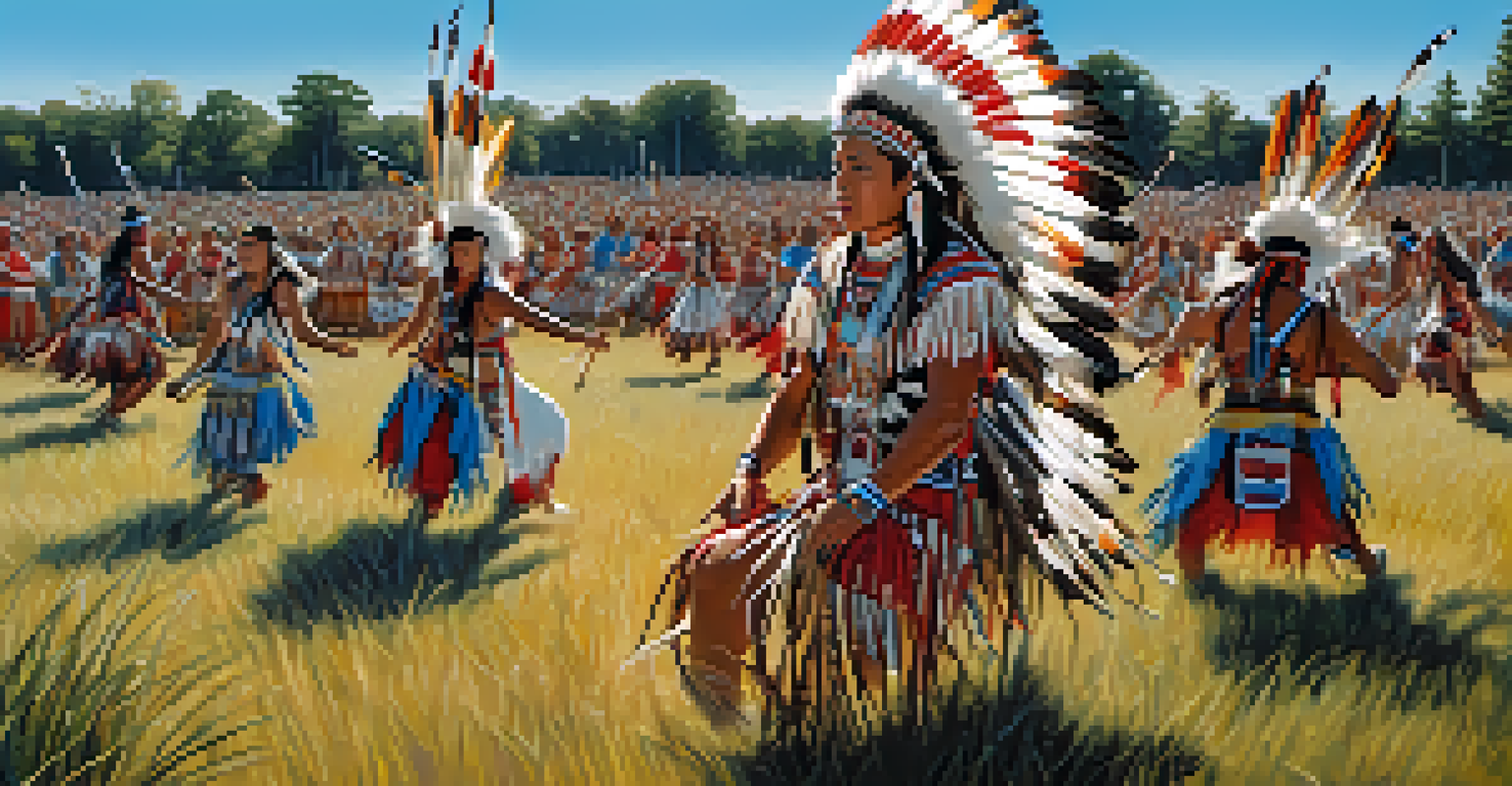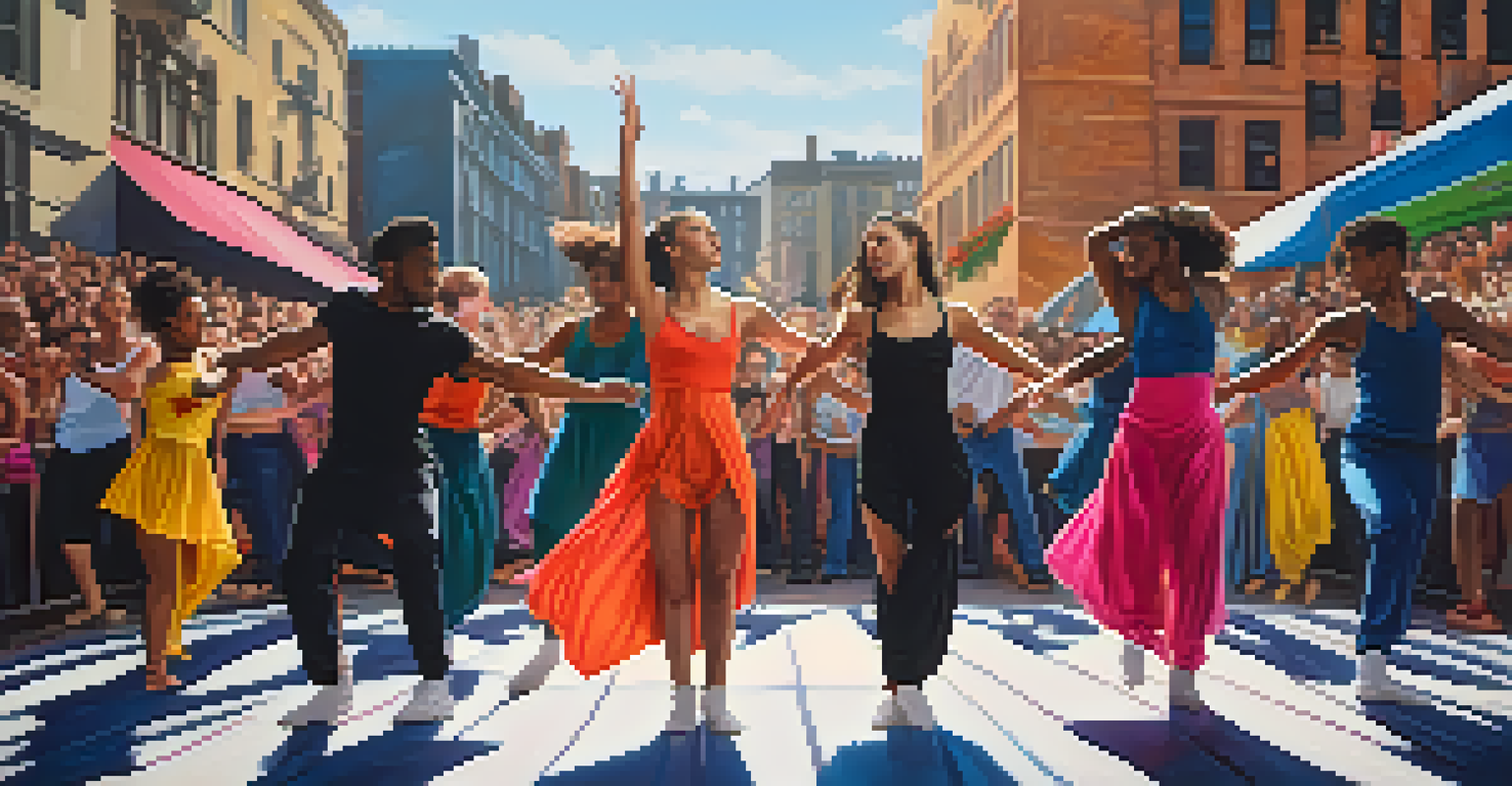Dance as a Form of Protest: Historical Contexts

The Roots of Dance as Protest in History
Dance has long served as a medium for expression, often reflecting societal issues. Throughout history, various cultures have used dance to convey messages of resistance and rebellion against oppression. From the rhythmic movements of indigenous peoples to the choreographed rituals of the oppressed, dance has been a potent tool for voicing dissent.
Dance is the hidden language of the soul.
These early forms of dance often emerged during times of struggle, conveying emotions that words sometimes couldn't capture. For instance, African American spirituals and dances during slavery encapsulated the longing for freedom and the resilience of the human spirit. These movements not only provided a sense of community but also fostered a shared identity in the face of adversity.
As we delve into the historical contexts of dance, it's essential to recognize how it has transformed over the centuries. The evolution of dance as protest reflects changing societal norms and the ongoing fight for justice, making it a powerful narrative in human history.
Dance in the Civil Rights Movement
The Civil Rights Movement of the 1960s in the United States saw dance emerge as a crucial form of protest. Activists used dance to promote unity and express their struggles, with performances often held during rallies and marches. Notably, the choreography of Alvin Ailey and the work of other artists highlighted the African American experience and resilience.

Ailey's signature piece, 'Revelations,' draws on spirituals, gospel music, and blues, instilling a sense of hope and strength. Through their movements, dancers conveyed messages of dignity and resistance, effectively communicating the urgency of their cause. This intersection of art and activism galvanized supporters and attracted national attention.
Dance as a Historical Protest Tool
Throughout history, dance has been a powerful medium for expressing resistance and rebellion against oppression.
Moreover, dance played a role in bringing diverse groups together, emphasizing solidarity among different communities. The use of dance as a medium for protest during this pivotal era illustrates how art can influence social change and inspire future generations.
Global Movements and Dance as Protest
Dance as a form of protest isn't limited to one region or time; it has appeared in various global movements. From the tango in Argentina's fight against dictatorship to the traditional dances of indigenous peoples protesting land rights, dance serves as a universal language for resistance. Each movement tells a unique story, highlighting the cultural significance of dance in activism.
Art is not a mirror held up to reality, but a hammer with which to shape it.
For example, during the 1980s, the tango became a symbol of resistance against the military dictatorship in Argentina, with dancers using their art to reclaim their identity and heritage. These performances were not just acts of rebellion but also a means of preserving culture under oppressive regimes. They showcased how dance can encapsulate both personal and collective struggles.
As we examine these diverse expressions, it becomes clear that dance transcends boundaries, connecting people across cultures and generations. This global perspective on dance as protest underscores its role in unifying individuals against common injustices.
Contemporary Dance and Social Justice
In today's world, contemporary dance continues to address pressing social issues, including race, gender, and climate change. Choreographers and dancers are increasingly using their platforms to raise awareness and inspire action. This modern approach blends artistry with activism, reflecting the complexities of current societal challenges.
For instance, the 'Black Lives Matter' movement has sparked a wave of dance performances that address racial injustice. Dancers like Carrie Mae Weems and others are creating pieces that resonate emotionally, inviting audiences to reflect on their role in the fight against systemic racism. These performances don't just entertain; they provoke thought and encourage dialogue.
Contemporary Dance and Activism
Today, contemporary dance continues to address critical social issues, merging artistry with activism to inspire change.
Furthermore, contemporary dance companies are collaborating with activists and organizations, demonstrating a commitment to social justice. This fusion of art and advocacy illustrates how dance can serve as a catalyst for change, providing a voice to those who may otherwise go unheard.
The Role of Dance in Indigenous Rights Movements
Indigenous communities worldwide have long used dance to assert their rights and express their cultural identity. Dance serves as a vital tool for storytelling, connecting generations and reinforcing community bonds. Through traditional dances, Indigenous peoples share their history, struggles, and aspirations, often in the context of land and sovereignty.
For instance, the powwow dance is not just a celebration but also a form of protest against colonization and cultural erasure. These gatherings allow Indigenous peoples to showcase their heritage while advocating for land rights and environmental justice. The vibrant movements and rhythms are a testament to their resilience and determination.
Moreover, the visibility of Indigenous dance in contemporary activism has inspired broader conversations about respect and recognition of Indigenous rights. By reclaiming their cultural practices through dance, these communities assert their identity while challenging historical injustices.
Dance as a Catalyst for Change
The act of dancing in protest often ignites conversations that lead to broader societal changes. When dancers take to the streets, they captivate audiences and draw attention to critical issues that demand action. This form of expression can be a powerful catalyst for change, inspiring individuals to engage with social movements.
For instance, flash mobs and public performances have emerged as innovative ways to raise awareness about various causes. These spontaneous displays of dance often capture the public's imagination, creating an emotional connection to the issues at hand. They highlight how art can disrupt the mundane and provoke important discussions.
Global Impact of Dance in Movements
Dance transcends cultural boundaries, serving as a universal language for resistance and connecting communities fighting for justice.
As history shows, dance can mobilize communities, foster solidarity, and inspire action. By harnessing the power of movement, dancers challenge the status quo and invite others to join the fight for justice.
The Future of Dance as Protest
As we look to the future, the role of dance in protest is likely to evolve alongside societal changes. With the rise of social media, dancers can now share their messages globally, reaching wider audiences than ever before. This digital landscape presents exciting opportunities for activism through dance, allowing for real-time engagement and collaboration.
Innovative choreographers are exploring new forms of expression, blending technology with traditional dance to create impactful performances. Virtual reality and multimedia experiences are expanding the ways that dance can convey messages, making it accessible to diverse audiences. This evolution reflects the dynamic nature of art and its ability to adapt to contemporary challenges.

Ultimately, the future of dance as protest will hinge on the creativity and passion of artists committed to social change. By embracing new platforms and techniques, dancers will continue to inspire action and empower communities to stand up for their rights.